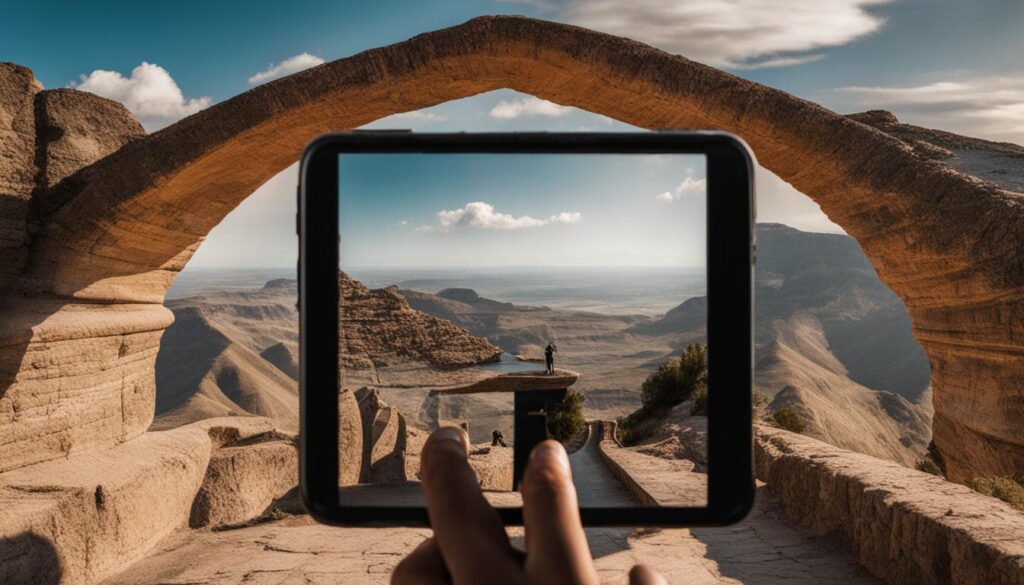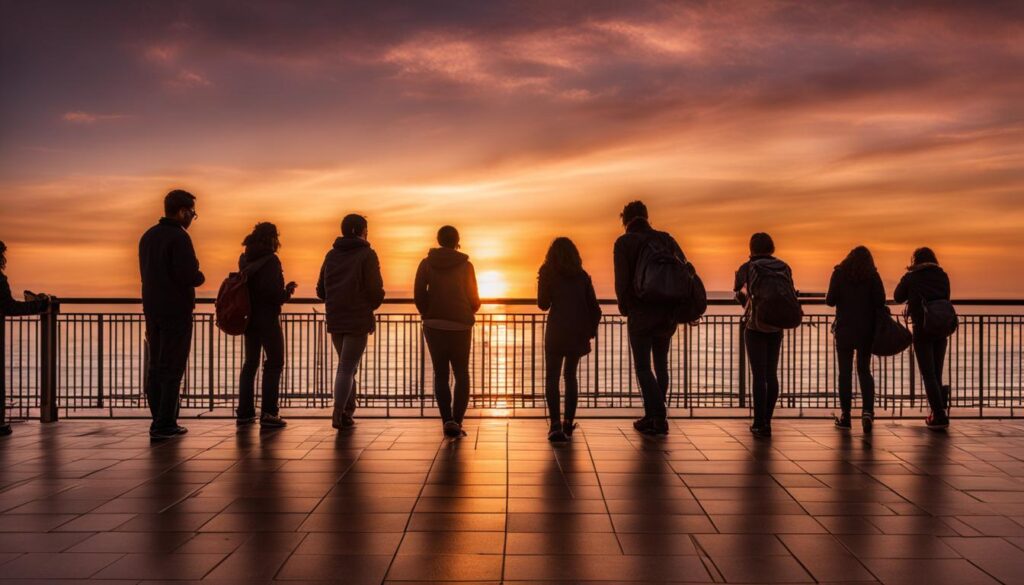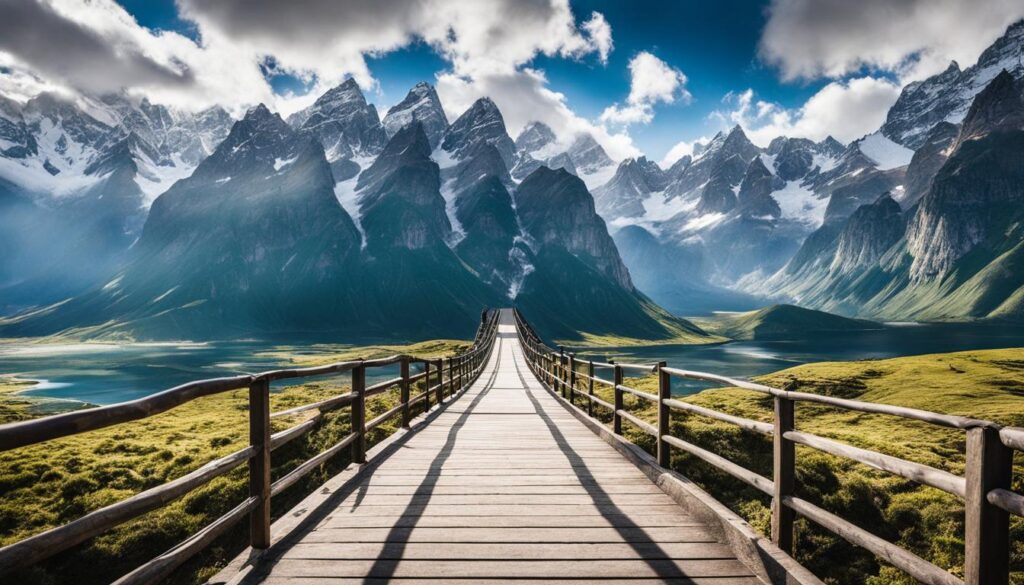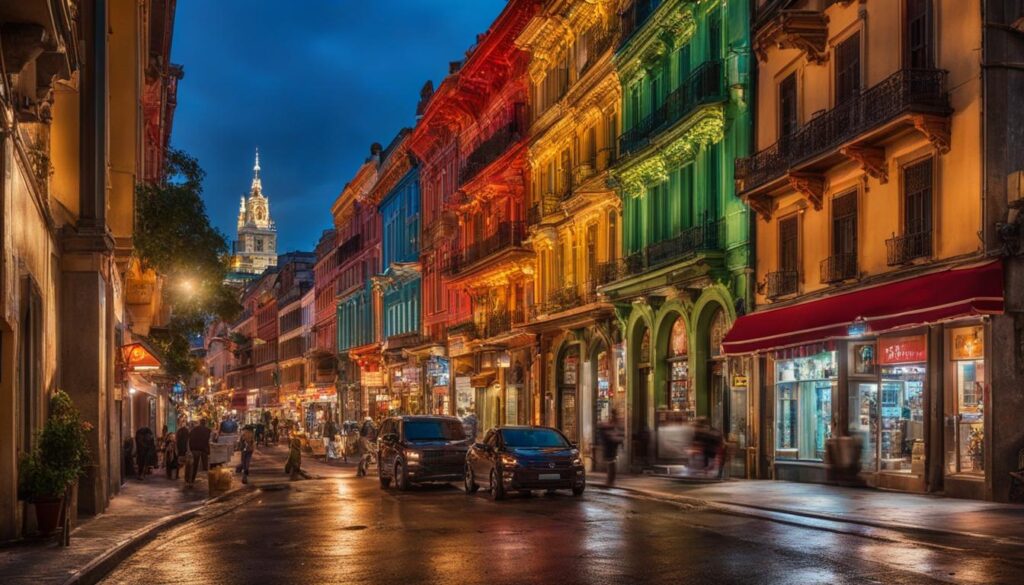Do you want to take your travel photography to the next level? Are you looking to capture stunning masterpieces that showcase the world’s beauty in a whole new light? Then, it’s time to enhance your travel photography composition skills. No matter if you’re a beginner or an experienced photographer, mastering composition techniques can transform your travel memories into mesmerizing keepsakes that you’ll treasure forever.
In this article, we will explore expert techniques to help you create visually captivating images that transport viewers to the places you’ve explored. From the basics of understanding composition to techniques like the rule of thirds, leading lines, framing, color, and depth, we’ll guide you through each step. Plus, we’ll provide advanced considerations, exercises, and practice tips to ensure you’re continually improving and refining your skills.
Are you ready to take your travel photography to the next level? Let’s dive in!
Understanding Travel Photography Composition
Travel photography is a unique art form that captures the essence of a place, its people, and its culture. However, it takes more than a camera and a plane ticket to create breathtaking travel photos. You must understand the fundamentals of travel photography composition to capture memorable images that stand out.
Composition is the arrangement of visual elements in a photograph. In travel photography, it’s the key to transforming your travel memories into stunning masterpieces that capture the world in a new light. Learning the basic principles and concepts will guide you in creating compelling and visually pleasing travel photographs.
| Travel Photography Tips | Composition Techniques for Travel Photography |
|---|---|
| Research your destination to understand its culture and customs. | Learn the basics of balance, symmetry, contrast, and framing to create visually appealing compositions. |
| Experiment with different angles, perspectives, and viewpoints to add variety to your shots. | Master the rule of thirds, leading lines, framing, color, and depth to create dynamic and engaging compositions. |
| Pay attention to lighting conditions, time of day, and weather to capture the right mood and atmosphere. | Use negative space, patterns, and other advanced techniques to create unique and thought-provoking compositions. |
Understanding travel photography composition is crucial to creating stunning images that capture the essence of a place. The artful arrangement of elements in your photographs will guide the viewer’s eye and evoke emotions, making the viewer feel as though they are part of the scene.
Mastering Composition
Using composition techniques effectively takes practice and experimentation. Take time to plan your shots before you click the shutter button, considering the placement of elements in the frame, the viewer’s perspective, and your creative intent. As with any art form, the more you practice, the better you will become at creating engaging and impactful photographs.
Rule of Thirds: A Powerful Composition Technique
The rule of thirds is a fundamental composition technique that can elevate your travel photos to the next level. To use the rule of thirds, you need to envision your frame divided into three parts horizontally and vertically, creating nine equal segments.
The rule of thirds suggests placing the key elements of your photo along the lines or the intersections of these segments. This technique helps you achieve balance and symmetry in your composition and draws the viewers’ eye towards your subject.
For instance, if you’re taking a landscape photo, place the horizon on the top or bottom third line rather than in the center. If you’re capturing a portrait, align the subject’s eyes along the top horizontal line and create negative space around them, providing a sense of balance in your frame.
The rule of thirds works well with many subjects, but it’s not a hard and fast rule. You can experiment with breaking the rule to create a sense of tension or asymmetry in your composition.
Leading Lines: Guiding the Viewer’s Eye
In travel photography, leading lines are an essential composition technique that can guide the viewer’s eye towards the main subject or focal point of your image. Leading lines can be formed by natural or man-made elements in your scene, such as roads, rivers, bridges, buildings, or tree branches.
To use leading lines, position yourself so that the lines lead towards your subject, and make sure the lines are sharp, straight, and well-defined in your frame. This will help create a visual path that directs the viewer’s eye towards the primary point of interest.
There are several types of leading lines, including horizontal, vertical, diagonal, and converging. Horizontal lines can evoke a sense of calmness or stability, while vertical lines can communicate strength or height. Diagonal lines can introduce dynamism or create a sense of movement, while converging lines can add depth and perspective to your composition.
Consider experimenting with different types of leading lines in your travel photography to create unique and compelling compositions. Placing your subject off-center and using leading lines to draw the eye towards it can also add interest and depth to your images.
Framing: Adding Depth and Focus
When it comes to travel photography, framing is a highly effective technique for adding depth and focus to your shots. By using natural elements or architectural structures to frame your subject, you create a visual pathway that draws the viewer’s eye to the center of the photograph. Not only does this add interest and intrigue to the composition, but it can also provide context and a sense of place.
For example, imagine photographing a local musician in a crowded street market. By framing the musician with the surrounding street vendors and onlookers, you can create a sense of place and highlight the subject as a unique and authentic representation of the culture.
When considering how to frame your travel photographs, there are several factors to keep in mind. First, be mindful of the placement of your subject within the frame. Aim to position them in a way that is visually appealing and captures their character or emotion.
You should also consider the framing elements themselves. If using natural elements such as trees or mountains, be aware of how they interact with the subject and how they add depth and balance to the composition. Architectural elements such as doorways, windows, and arches can also be used to add visual interest and context to your shots.
Pro Tip: Experiment with different angles and positions to create a dynamic and engaging frame. Don’t be afraid to take risks and play with light and shadow to add dimension and depth to your compositions.
Overall, framing is a powerful tool in your travel photography arsenal. By utilizing the natural elements and architectural structures around you, you can craft visually striking and meaningful compositions that truly capture the essence of your travel experiences.
Using Color: Enhancing Mood and Impact
The use of color is an excellent way to amplify the emotional impact and storytelling in your travel photographs. Color can help evoke specific moods and feelings that will enhance the interest for viewers. Understanding how to use color effectively is essential in creating captivating compositions that attract people to your art.
Colors can have a profound impact on the overall feel of your photograph. Warm colors like reds, oranges, and yellows can create a sense of energy and brightness, making the subjects feel more alive. In contrast, cool colors such as blues and greens can be more calming and peaceful, taking on a softer, more delicate role.
How to Choose the Right Colors?
Looking for colorful subjects to photograph is one thing, but finding subjects that match specific complementary or analogous color schemes can create even more interest for viewers. Complementary colors are colors that are opposite one another on the color wheel, while analogous colors are colors that sit next to each other.
When choosing colors, make sure to consider the overall mood or feeling you want to convey as well. For example, warm, bright colors may not be ideal for a shot of a snowy landscape, where cooler tones like blues and whites would create a more natural harmony with the environment.
Color Editing Techniques
Editing software such as Adobe Lightroom or Photoshop provides the necessary tools to enhance and adjust colors in your travel photographs. Tools like HSL (Hue, Saturation, Luminance) or RGB (Red, Green, Blue) allow for precise adjustments that allow you to create a unique mood or ambiance.
Creating Depth: Adding Dimension to Your Photos
Creating a sense of depth in your travel photos can transform them from two-dimensional snapshots into immersive, captivating images that draw the viewer in. By adding layers, foreground elements, and playing with perspective, you can create the illusion of depth and take your travel compositions to the next level.
One effective technique for creating depth is through layering. This involves adding multiple layers or planes of interest within your photo, such as foreground, middle-ground, and background, to give the impression of depth. You can achieve this by including natural elements such as foliage or rocks in the foreground, architectural structures like bridges or buildings in the middle-ground, and distant mountains or skyscrapers in the background.
Foreground elements can add an extra dimension to your travel photos, creating a sense of depth and scale. Use leading lines or a natural arch created by tree branches or rock formations to frame your subject and draw the viewer’s eye into the image.
Perspective is another powerful tool that can add depth to your photos. Experiment with different angles and viewpoints, such as shooting from a low angle or including a receding path or road in your composition to create an illusion of depth.
“Depth is not just a concept but also a feeling. It adds a certain dimension of drama, anticipation, and storytelling to your photos. With the right techniques, you can take your travel photos from flat to fabulous.”
Composition Considerations: Beyond the Basics
When it comes to travel photography composition, sometimes going beyond the basics can be the key to creating truly unique and engaging photographs. It’s worth exploring some advanced concepts to take your travel photography to the next level.
Negative Space
Negative space is the area around your subject that’s left intentionally blank. Using negative space can help to draw the viewer’s attention to your main subject and create a sense of minimalism in your photos. Don’t be afraid to leave plenty of empty space in your images – it can add impact and depth to your composition.
Symmetry
Symmetry refers to creating balance and harmony in your photos by using a mirror effect. Look for symmetry in buildings and other architecture, or even in nature. Symmetrical subjects can give a sense of stability and order to your photos.
Patterns
Patterns are repetitive elements that can add texture and visual interest to your photos. They can also create a sense of rhythm and movement in your composition. Look for patterns in architecture, textiles, and nature. Experiment with different angles and focal lengths to find the most compelling composition.
Different Angles
Changing your angle can completely transform the way your photo looks. Don’t be afraid to get low or high to create a unique perspective on your subject. Different angles can add dynamism and drama to your images, allowing you to add your own creative touch to your travel photos.
“Mastering travel photography composition is an ongoing process. Continually experiment and develop your own style to create stunning travel photos that tell your unique story.”
Composition Exercises and Practice
To improve your travel photography composition, practice is key. Here are some exercises to help you refine your skills:
- Analyze your work: Review your past travel photos and assess their composition. Identify the elements that work well and areas that could be improved. Repeat this exercise after taking new photos to track your progress.
- Get inspired: Look at the travel photographs of professional photographers or browse through picture books for inspiration. Pay attention to how they compose their shots and consider how you can incorporate those techniques into your own work.
- Experiment: Try different composition techniques, such as the rule of thirds or leading lines, and see how they affect your travel photos. Don’t be afraid to take risks and try new approaches.
- Critique your work: Share your travel photographs with other photographers or upload them to photography forums for constructive feedback. Consider their suggestions and apply them to your next shoot.
- Practice regularly: Set aside time for regular practice and apply the composition techniques you’ve learned. The more you practice, the more natural it will become, resulting in better and more impactful travel photographs.
Remember to enjoy the process and experiment with different styles and techniques. With time and practice, your travel photography composition skills will improve, resulting in stunning and captivating travel photos.
Conclusion
Now that you’ve learned the fundamentals of travel photography composition and explored advanced techniques, you’re ready to take your skills to the next level. Remember to utilize the rule of thirds, leading lines, framing, color, and depth to create visually captivating images that tell a story.
Don’t be afraid to experiment with different approaches and practice regularly to refine your skills. Analyze and critique your own work and seek inspiration from other talented photographers.
Mastering travel photography composition will allow you to capture the world in a new light and transport viewers to the places you’ve explored. So, with your camera in hand, go out there, explore the world, and keep capturing those breathtaking moments. Happy shooting!

















































